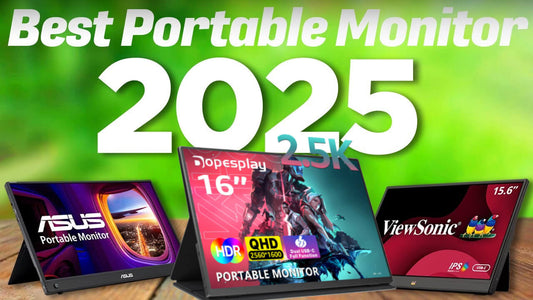The Importance of Choosing The Right Monitor for Gaming
Share
When shopping for a gaming monitor, there are many factors to consider. The right choice can significantly improve your gaming experience, offering smoother gameplay and better performance. In this article, we’ll explore the most important considerations when choosing the perfect monitor for your gaming needs.

Why the Right Gaming Monitor Matters
With the increasing popularity of 4K gaming and high-refresh-rate monitors, choosing the right one for your needs can be overwhelming. The gaming monitor you pick affects everything from visual clarity to your in-game responsiveness. Let’s dive into why the right monitor is crucial for gamers.
Choosing a monitor for gaming isn't a decision you make frequently. It’s an investment, and the quality of the monitor can have a profound impact on your gaming experience. While most gamers focus on the computer’s CPU or GPU, the monitor is often overlooked. However, it is just as important. A monitor with the right features can enhance your gameplay, offering better frame rates and more vibrant graphics. A poor-quality monitor will hinder your performance, leading to lag, motion blur, or even visual artifacts. Therefore, selecting the best gaming monitor that fits your needs and budget is essential.
Key Factors to Consider When Choosing a Gaming Monitor
- Resolution - Higher resolutions, such as 4K or 1440p, provide crisper and more detailed images, but you will need a more powerful system to drive them.
- Refresh Rate - A higher refresh rate (120Hz, 144Hz, or 240Hz) offers smoother motion in fast-paced games, which can make a significant difference in competitive gaming.
- Response Time - Lower response times (1ms to 5ms) reduce ghosting and blur, which is crucial for fast action games like shooters.
- Panel Type - IPS panels offer vibrant colors, while TN panels are faster but offer lower image quality. VA panels provide the best contrast ratio.
- Adaptive Sync Technology - Technologies like G-Sync and FreeSync eliminate screen tearing and stuttering for smoother gameplay.
Gaming Monitors vs. Regular Monitors
Many people don’t realize the difference between a regular monitor and a gaming monitor until they try one. While regular monitors are great for general tasks, gaming monitors are specifically built to handle the demands of modern games. They are optimized for high-speed performance, reducing input lag and enhancing overall gameplay.
Gaming monitors come with features such as faster refresh rates, lower response times, and better color accuracy to provide gamers with the best possible experience. These features are important for players who are aiming for top-tier performance, as even a small lag or a blurry image can negatively affect your gameplay.
Monitor Recommendations
If you're looking for the best gaming monitor to enhance your experience, here are a couple of excellent choices:
- 16-inch Portable Monitor for Gaming – A sleek, portable monitor offering 2.5K FHD resolution, ideal for both casual and competitive gaming.
- 15.6 Inch 4K Portable External Monitor – Perfect for gamers who need portability without compromising on resolution and color accuracy.
Conclusion
Choosing the right gaming monitor can significantly affect your gaming experience. From resolution to refresh rate, every detail matters when you're looking to improve performance. Always consider the specific needs of your games and hardware when making your purchase to ensure you're getting the best monitor for your setup.
Explore More Portable Monitors
- Best value 15.6" FHD portable monitor
- The best 16'' monitor for gaming
- Best 15.6'' 4K Portable Monitors for Professionals
- Best 14.1'' Dual Portable Monitors for Enhanced Productivity
- Best 15.6'' Portable Monitors with Touchscreen Functionality







